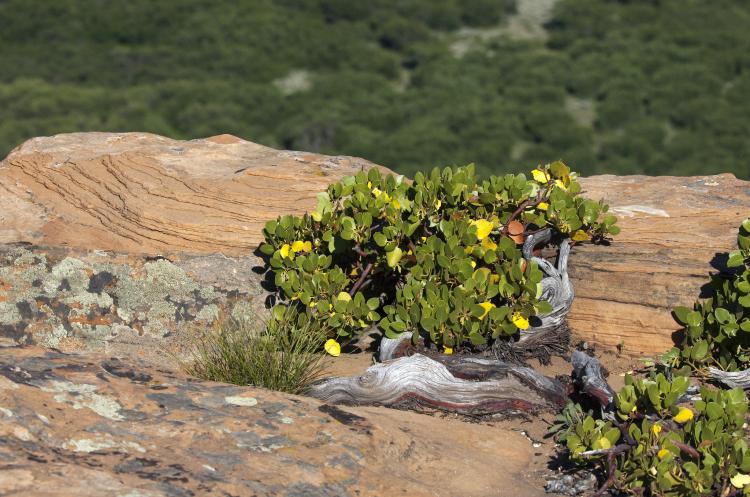Manzanita’s curious red bark
I had arrived at Leonards Ridge on the Uncompahgre Plateau, a shelf of rock at the top of a cliff, chosen for its likelihood of a scenic vista to the east. I set up my tent and was looking for the perfect shot at sunset when I noticed the red bark and bright foliage of a manzanita.
The conspicuously red bark of greenleaf manzanita warns insects of bitter taste and poisons. Photo by Jeff Mitton.
I had come to appreciate the beauty of manzanitas when I took a postdoctoral year at the University of California at Davis and spent considerable recreational time in both coastal and foothill parks. In chaparral environments, manzanitas grow so densely that they form shrub thickets. The mature bark of manzanitas peels naturally, leaving a deep red surface as smooth as marble. Approximately 40 species of manzanitas grow in California and there is a bewildering diversity of subspecies and hybrids.
Colorado has just one species of manzanita, Arctostaphylos patula, or greenleaf manzanita, which is found from the western slope of Colorado to the Coastal Range in California and from Baja to the state of Washington. Its elevational range is from 1,500 to 12,000 feet. A close relative, Arctostaphylos uva-ursi, or kinnikinnick, has an even broader range, being native to all of the northern continents. These two species hybridize wherever they both occur.
Greenleaf manzanita is an evergreen shrub that grows between three and six feet tall. In some populations, but not all, it produces tubers, which allow it to spread clonally.
The deep red bark is a thing of beauty but it raises questions as well, for it is rare outside the manzanitas and their ancestors, madrone trees and shrubs in the genus Arbutus. The red color comes from a variety of compounds, but principally tannins, that produce both bitter taste and rich color. My hunch is that the beautiful bark of manzanitas is aposematic or warning coloration, advertising the bitter and poisonous compounds concentrated in the bark. Herbivores that survived the experience would immediately learn and long remember that red bark tastes bad and is poisonous.
The mature bark naturally peels away in thin sheets, leaving very smooth bark. By peeling each year, Manzanita jettisons any fungi, parasites, lichens and mosses that have managed to adhere. But in addition, glandular secretions make bark remarkably slippery, which is an effective defense against crawling insects.
As part of his PhD thesis research, Scott Ferrenberg tested whether smooth bark might deter attacks by mountain pine beetles. You may have noticed that some limber pines have rough bark, some have smooth bark, and some have patches of smooth and rough. He took live and healthy mountain pine beetles from beetle traps and placed them on live limber pines. Each beetle got two opportunities on the same tree, one trial on rough bark and one on smooth bark. The results could not have been clearer—beetles explored on rough bark for five minutes, when that trial was ended. But when placed on smooth bark, virtually all of them fell off in less than 30 seconds. Smooth, slippery bark is inaccessible for some insect herbivores.
The British Ecological Society awarded Scott the Haldane Prize for his experimental design, the clarity of the results and their broad implications. The results would certainly help understand why other trees, such as beeches and manzanitas, have smooth bark. Scott received his Ph.D. in 2014 and is currently a postdoctoral fellow at the U.S. Geological Survey's Southwest Biological Science Center in Moab, UT.
Greenleaf manzanita grows in communities that burn frequently: with ponderosa pine and Gambel oak in Colorado and in California chaparral. Consequently, manzanita's sprouting and seed germination are adapted to fire. It has a basal burl, usually buried, which sprouts after the fire. But in addition, seeds of greenleaf manzanita can remain dormant in the soil for centuries, waiting for a fire to pass followed by the cold of winter before germinating.


